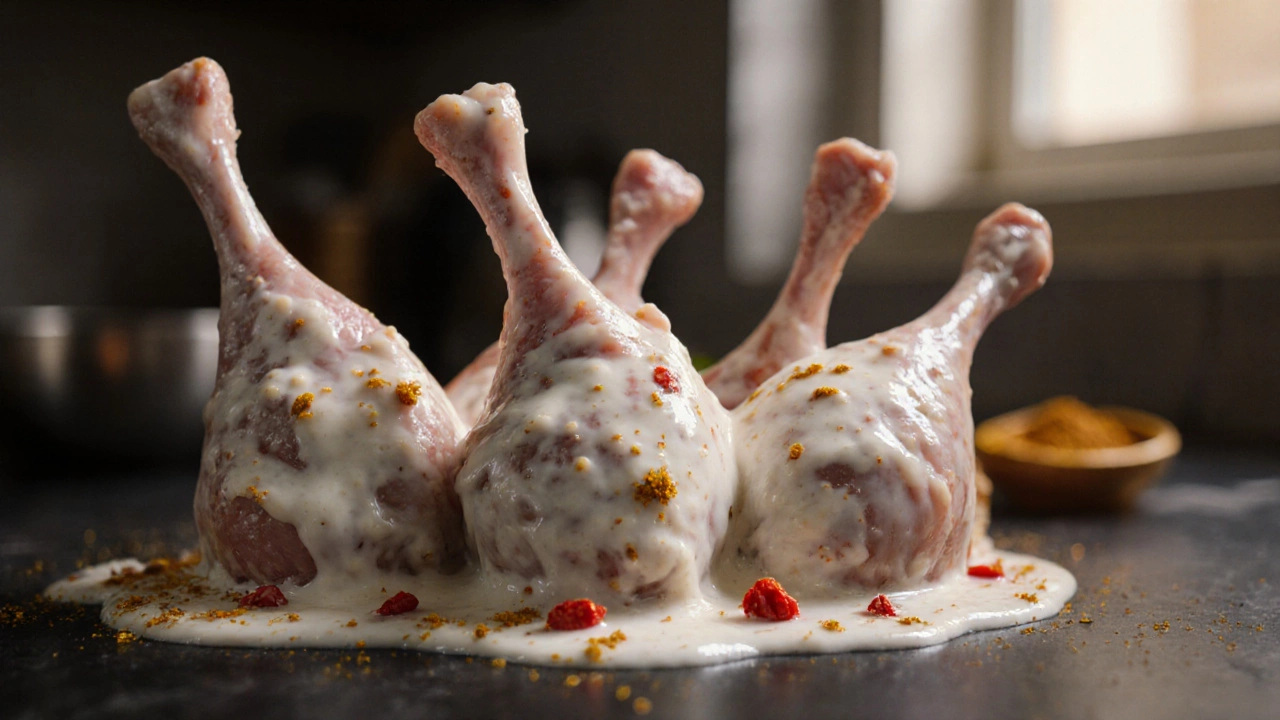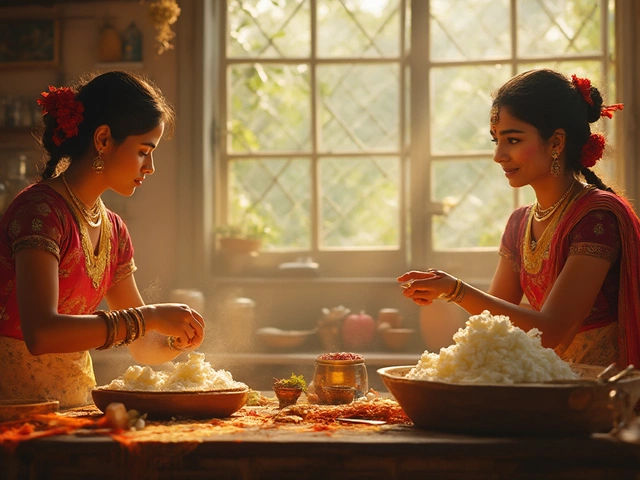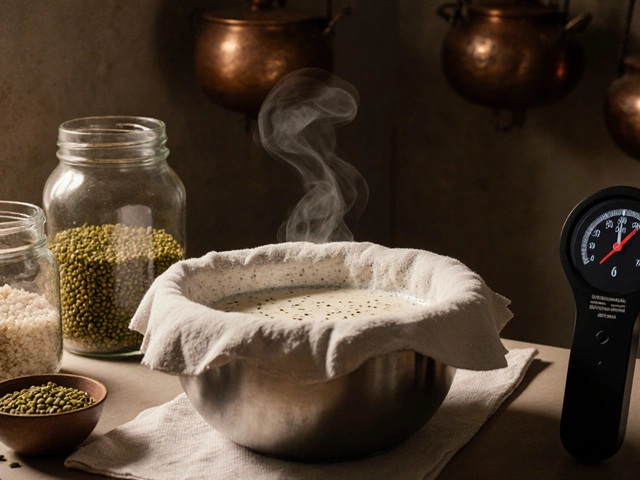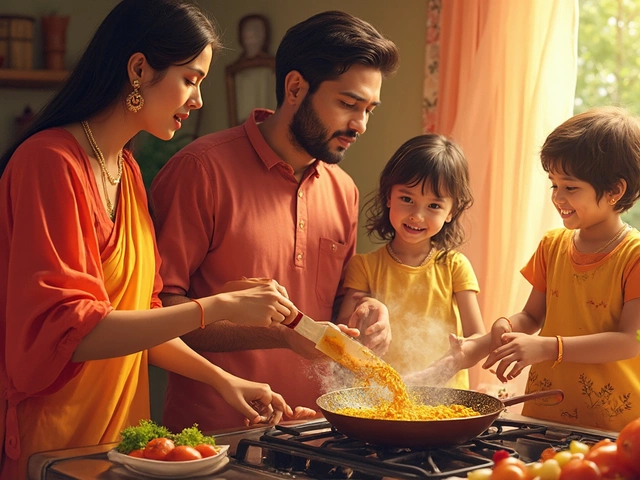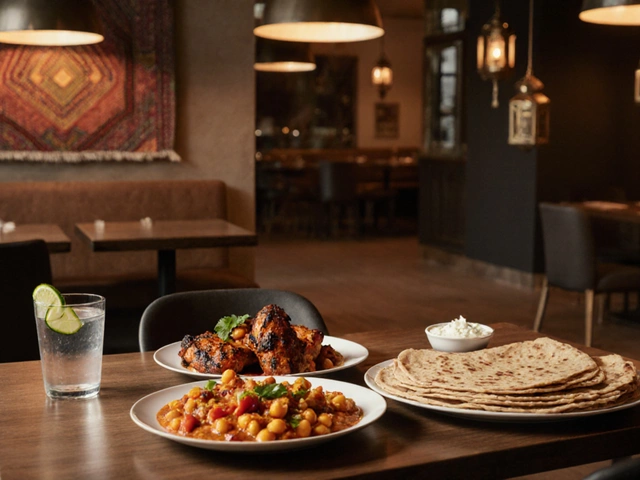Tandoori Chicken Calculator
Make Perfect Tandoori Chicken
Enter your cooking details below to get optimal marination and cooking recommendations based on the science behind tender tandoori chicken.
Results
Ever wondered why tandoori chicken stays juicy and fork‑tender even after being cooked at blistering heat? The answer lies in a mix of chemistry, traditional techniques, and a dash of patience. Below you’ll get the science behind the melt‑in‑your‑mouth texture, the exact steps to recreate it at home, and troubleshooting tips to keep the meat from drying out.
What Makes Tandoori Chicken Different?
At its core, Tandoori Chicken is a marinated poultry dish cooked in a cylindrical clay oven called a Tandoor. The iconic red hue comes from a blend of spices and sometimes food coloring, but the tenderness comes from three key factors:
- Acidic & enzymatic action from the yogurt base that gently breaks down muscle fibers.
- High, dry heat that sears the outside while locking moisture inside.
- Short cooking time once the surface is charred, preventing over‑cooking.
Understanding each factor helps you control the outcome, whether you’re using a professional tandoor, a charcoal grill, or a home oven.
The Chemistry of a Tender Marinade
Traditional recipes call for Yogurt as the liquid base. Yogurt is more than a tangy flavor carrier - it’s a natural meat‑tenderizer. Here’s why:
- Lactic Acid: The mild acidity lowers the pH of the chicken’s surface, loosening the protein structure.
- Calcium‑Activated Enzymes: Yogurt contains enzymes that target Collagen and other connective tissues, turning tough fibers into gelatin.
- Moisture Retention: The dairy proteins form a coating that reduces water loss during high‑heat cooking.
To maximize these effects, aim for a 30‑minute to 12‑hour marination window. Longer isn’t always better - beyond 12hours the acid can start “cooking” the meat, leading to a mushy texture.
Key Spice Players and Their Roles
While the tenderizing power comes from the yogurt, the spice mix adds flavor, aroma, and a little heat. The most common components are:
- Garam Masala - a warm blend of cumin, coriander, cardamom, and cloves that deepens flavor.
- Paprika or Kashmiri red chili - provides color without overwhelming heat.
- Ground ginger and garlic - add pungency and also contain enzymes that aid tenderization.
- Lemon or lime juice - a secondary acid source that brightens the taste.
Balancing these spices ensures the final dish is aromatic but not overpowering, letting the chicken’s natural juiciness shine through.
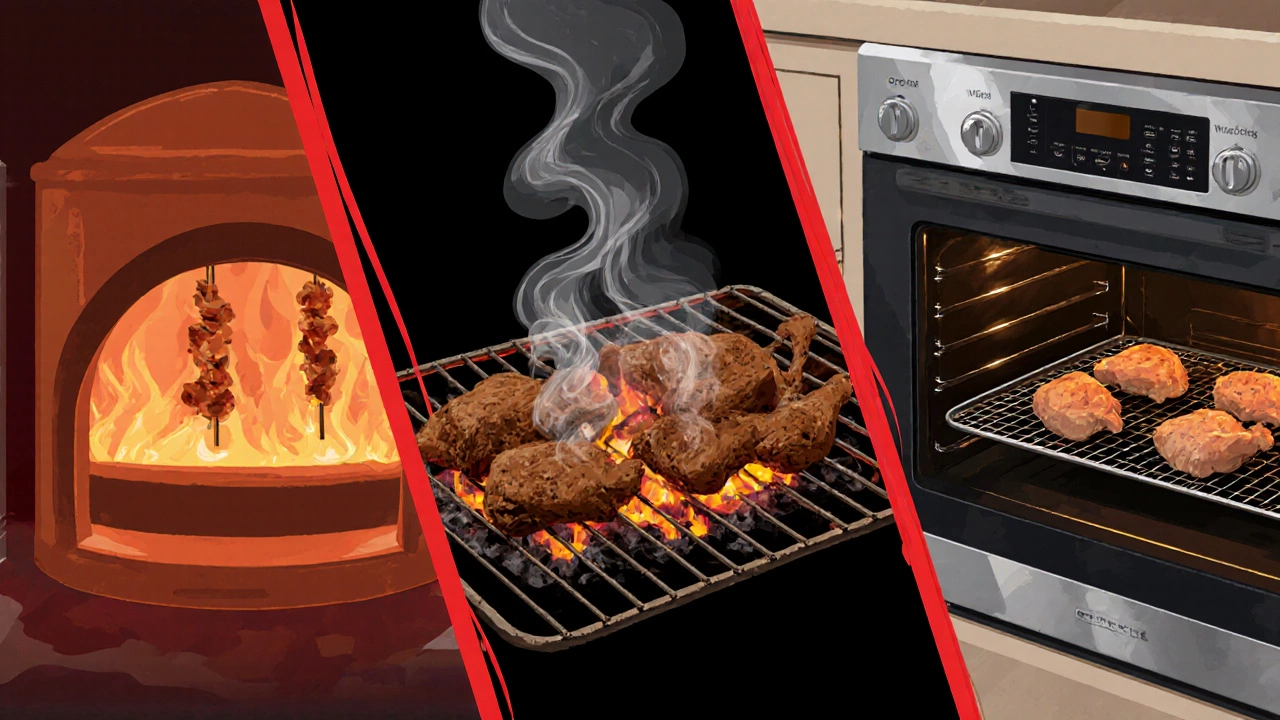
Choosing the Right Cooking Method
Traditional tandoors reach 480‑500°F (250‑260°C) and circulate hot air around the meat. If you don’t own a tandoor, you can still mimic the effect. Below is a quick comparison of three popular methods.
| Method | Typical Temp | Cooking Time | Moisture Retention | Flavor Profile |
|---|---|---|---|---|
| Tandoor | 480‑500°F | 8‑10min | High - rapid sear locks juices | Smoky, charred, authentic |
| Charcoal Grill | 400‑450°F | 12‑15min | Medium - indirect heat helps | Smoky, slightly less uniform char |
| Oven (broiler) | 450‑475°F | 12‑14min | Medium‑Low - can dry if overcooked | Less smoky, more controlled |
Each method can produce tender chicken, but the tandoor’s intense, enveloping heat is the gold standard. If you’re using an oven, place the rack close to the broiler and pre‑heat the broiler for at least 10minutes to simulate that high‑heat environment.
Step‑by‑Step Recipe for Ultra‑Tender Tandoori Chicken
- Gather the ingredients:
- 1kg (2lb) bone‑in chicken pieces (drumsticks, thighs, or breast halves).
- 200g (¾cup) plain Yogurt, preferably whole‑fat.
- 2tbsp lemon juice.
- 2tbsp ginger‑garlic paste.
- 2tbsp Garam Masala.
- 2tbsp Kashmiri red chili powder.
- 1tbsp ground cumin.
- 1tbsp smoked paprika.
- ½ tsp salt (adjust to taste).
- 2tbsp oil (optional, helps browning).
- Make the marinade: In a bowl, whisk yogurt, lemon juice, ginger‑garlic paste, all spices, and salt until smooth. The mixture should be thick enough to cling to the chicken.
- Coat the chicken: Pat the pieces dry with paper towels. Using hands (wear gloves if you prefer), rub the marinade all over, ensuring it gets into every crevice and under the skin.
- Marination time: Cover the bowl with cling film and refrigerate for 4‑8hours for a balance of flavor and tenderness. If you’re short on time, 30minutes still works, but the texture won’t be as soft.
- Pre‑heat your cooking device:
- Tandoor/Charcoal Grill: Light charcoal, let it ash over, then insert the tandoor or skewers. Aim for 480°F.
- Oven: Set to 475°F and turn on the broiler 10minutes early.
- Cook the chicken: Skewer the pieces (if using a tandoor or grill) or place them on a wire rack over a baking sheet (oven). Cook for 8‑12minutes, turning once, until the internal temperature hits 165°F and the surface shows a deep caramelized color.
- Rest before serving: Transfer the hot chicken to a plate, drizzle with a little fresh lemon juice, and let it rest 5minutes. Resting lets the juices redistribute and keeps the meat moist.
Serve with sliced onions, fresh coriander, and a side of mint‑yogurt chutney for the full experience.
Common Mistakes and How to Fix Them
Even seasoned cooks hit snags. Here are the most frequent problems and quick fixes:
- Dry chicken: Usually caused by over‑marinating (acid breaks down too much) or overcooking. Cut the marination to 4‑8hours and use a meat thermometer for precise timing.
- Spice crust flakes off: Happens when the surface isn’t dry before searing. Pat the chicken dry after removing from the fridge, then let it sit at room temperature for 15minutes before cooking.
- Uneven color: Might be due to inconsistent heat. Rotate the skewers or move the tray halfway through cooking to expose all sides to the same temperature.
- Off‑flavor from burnt spices: High heat can scorch delicate powders. Add a splash of oil to the marinade or sprinkle a thin layer of butter halfway through cooking to protect the spices.
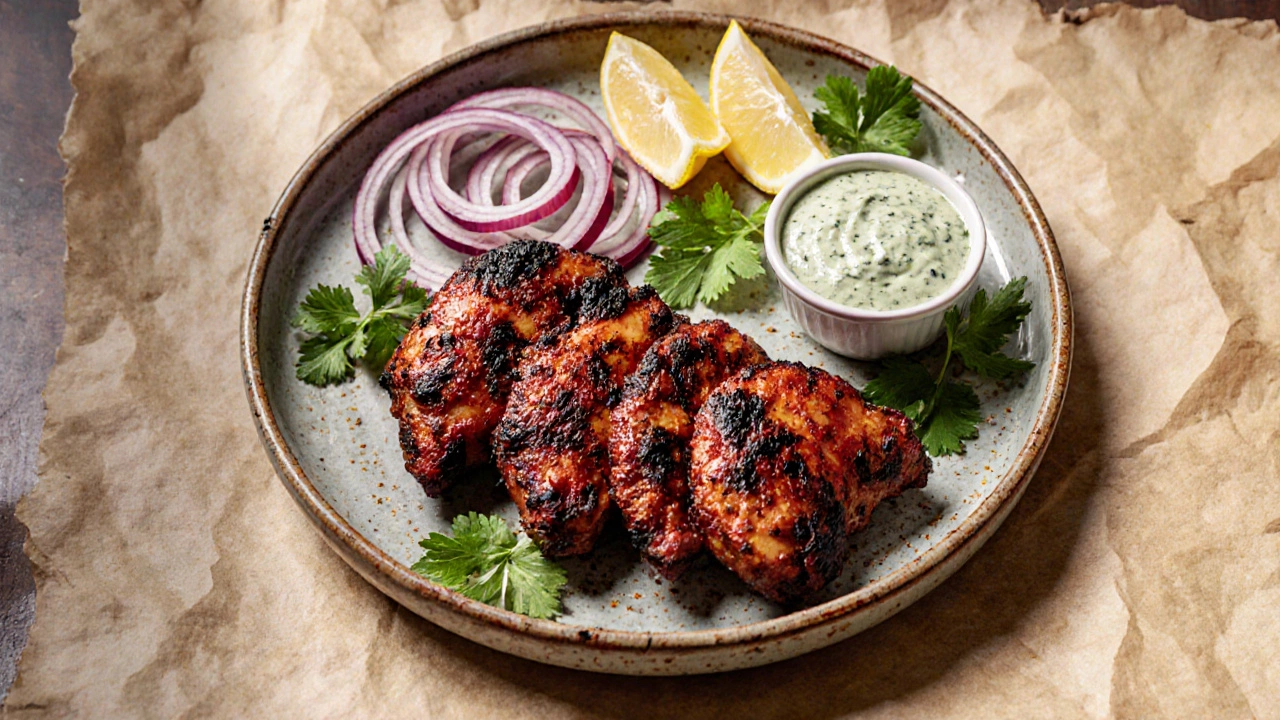
Quick Checklist for Perfectly Tender Tandoori Chicken
- Use whole‑fat yogurt for maximum enzymatic activity.
- Keep marination between 30minutes and 12hours.
- Target cooking temperature of 460‑500°F.
- Cook until internal temp reaches 165°F; no longer.
- Rest 5minutes before cutting.
- Optional: brush with a thin layer of oil for extra crispness.
Frequently Asked Questions
Frequently Asked Questions
Can I use skim yogurt instead of whole‑fat?
Skim yogurt works, but it lacks the fat that helps coat the chicken and retain moisture. If you go low‑fat, add a tablespoon of oil to the marinade to compensate.
Is a tandoor essential for tenderness?
No, but the tandoor’s high, even heat gives the classic sear. A hot charcoal grill or a pre‑heated oven with the broiler can achieve similar tenderness when you follow the temperature and timing guidelines.
What if I don’t have a grill or oven?
You can pan‑sear the chicken in a heavy cast‑iron skillet over high heat, then finish it under a broiler for 2‑3 minutes to get the char. Keep the skillet covered for the first few minutes to trap steam and stay tender.
How long can I keep the marinated chicken?
In the fridge, the marinated chicken stays safe up to 24hours. For longer storage, freeze it in a zip‑lock bag; thaw overnight before cooking. Note that freezing slows the tenderizing action, so you may want to add a splash of lemon juice after thawing.
Can I use boneless chicken breast?
Yes, but breast meat dries out faster. Reduce cooking time by 2‑3minutes and consider adding a little extra yogurt to the surface right before cooking to keep it moist.
With these science‑backed tips, you’ll be able to serve up tandoori chicken that’s consistently juicy, tender, and full of flavor-whether you’re at a backyard BBQ or a tiny kitchen in Cape Town.





